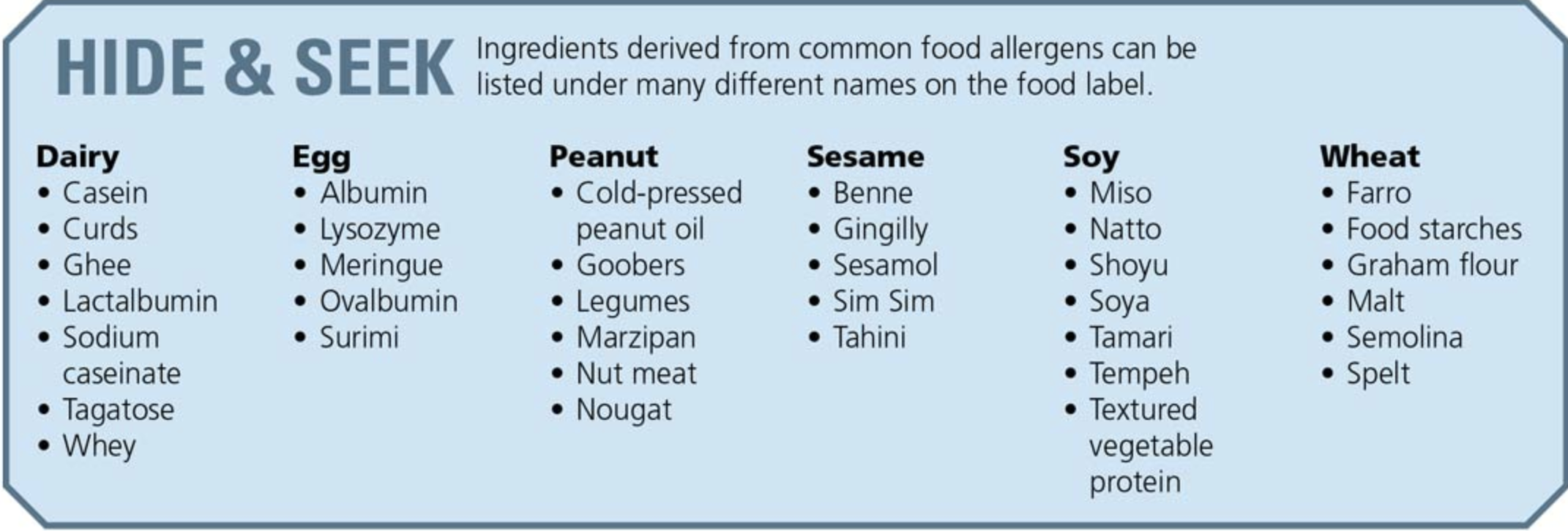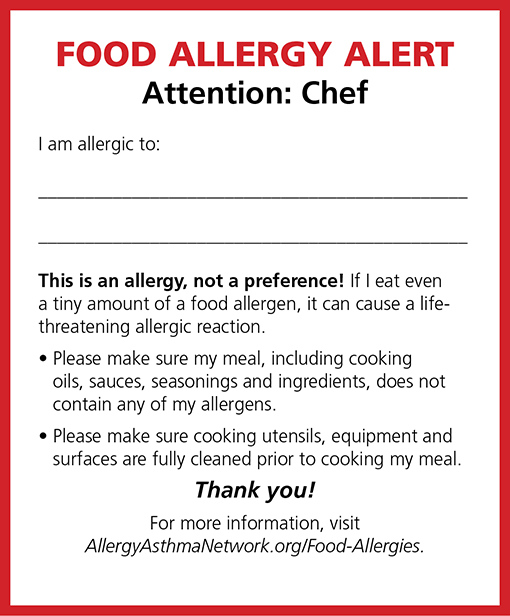Living with food allergies isn’t easy, especially when you or your family member is newly diagnosed.
It’s important to learn how to live safely with food allergies. The two key issues to learn are:
- preventing allergic reactions from happening by learning how to keep the environment and food safe from exposure to food allergens
- being prepared to treat an allergic reaction, should one occur
There are numerous issues to learn how to navigate life with food allergies. What follows are some of the important issues to learn and tips to make life easier.
How do I read food labels for food allergies?
Label reading can be tricky – but understanding the basics is the single most important thing you can do to identify foods that you can safely eat.
We do have some laws on our side to assist us. The most important, the Food Allergen Labeling and Consumer Protection Act (FALCPA), is designed to make it easier for people with food allergies to identify allergens in packaged food products.
How does FALCPA help me read labels for food allergies?
FALCPA mandates that labels of food packages containing one of the “top 8 food allergens” list the allergen in clear language, either in the ingredients or in a “Contains” statement placed immediately after or next to the ingredients.
The top 8 food allergens are:
- milk
- hen’s egg
- wheat
- soy
- peanut
- tree nut
- fin fish
- shellfish
The law also applies to any food flavoring, spice, coloring or processing aid.
The law does not apply to meat or poultry, certain whole egg products governed by the US Department of Agriculture, sesame and other seeds and gluten-containing grains other than wheat.
Molluscan shellfish, such as clams, oysters, mussels and scallops are not considered a major food allergen under the labeling laws.
Food manufacturers are not required to list highly refined peanut, tree nut or soy oils because processing separates the allergen protein from the oil and they are considered safe.
What are some label reading tips for food allergies?
Look for the “Contains” statement
- Put the item back on the shelf if the allergen you need to avoid is listed in the “Contains” statement.
- If there is no “Contains” statement, read the full ingredient list to check for your allergen.
- Do not buy a food that contains your allergen in the “Contains” statement or the list of ingredients.
Avoid foods with advisory statements
- Advisory statements can vary from product to product. Examples include: “May contain,” “Produced in a facility that,” or “Manufactured on shared equipment with”
- If a food allergen is listed in an advisory statement, this means that there’s a chance the allergen is present or exposed to your allergen.
- Avoid products that contain your allergen(s) in advisory statements
Read Labels every time you shop
- Food manufacturers can change ingredients often. Check ingredient lists each time you purchase a food.
If in doubt, don’t eat a food
If you’re unsure if a food product contains your allergen, either don’t buy it or check with the manufacturer.

What is cross-contact regarding food allergies?
When an unsafe food allergen comes into contact with a food that’s safe for you, it’s called “cross-contact.”
Cross contact can happen during food preparation, cooking or serving. Examples of cross contact can include when you:
- dip a knife in the jelly jar after using it to spread peanut butter
- use the same grill or pan to cook a hamburger after it was used to cook salmon
- chop almonds on a cutting board and then slice a tomato without cleaning the board first
- remove nuts from a salad. Traces of tree nut allergen will still be present in the salad.
How do I avoid cross-contact?
Wash hands
Wash hands in soap and water before preparing a meal. Commercial hand wipes will also help; hand sanitizers do not.
Wash all surfaces, utensils and equipment
Wash cutting boards, dishes, pots, pans and countertops thoroughly with hot, soapy water after preparing food. Consider having dedicated dishes, pans and sponges that allergens don’t touch.
Keep safe foods safe
Store allergen-safe foods on a separate shelf in the refrigerator and cupboard. Use stickers to identify allergen-safe foods.
Use the no sharing rule
Never share food, utensils or drinks.
Avoid buffets or cafeterias
Buffets and cafeteria-style serving has a greater risk of cross-contact due to shared utensils and spilled foods.
Can I dine out with food allergies?
Eating out is an American pastime, but if you have a food allergy, it requires advance planning and special attention at the restaurant to make sure the food you order is safe.
To plan for a safe meal at a restaurant:
- Call the restaurant ahead of time or check menus online before eating out. Sometimes restaurants will offer an “allergy menu.”
- Communicate with the restaurant staff about your food allergies. A chef card is useful that lists your allergies. Ask that it be given to the chef or kitchen staff.
- Read menus closely and don’t order foods likely to cause an allergic reaction. Ask about ingredients.
- Carry two epinephrine auto-injectors with you to treat anaphylaxis if it should occur.
Establish an open dialogue with everyone – the manager, host, servers and even the chef. Work with them to ensure you receive a safe meal.
The more you talk with the restaurant staff, the more you develop an intuition whether the restaurant is a safe place to dine. For example, as you speak to the restaurant staff and they seem to be confusing your food allergies with a request for a choice of a gluten-free meal, that’s a red flag.
In order to make the safest choices when dining out, choose meals with simple ingredients that are familiar to you. It is also helpful to the restaurant staff if you are flexible about safe suggestions that they recommend.
Many restaurants and quick-service eateries now list allergens on their menus and post food allergy awareness information in the kitchen area. Depending on the state you are dining in, some like Massachusetts have laws that require these protocols. Cruise ships will cater to food allergies if you notify the cruise line when you book the trip.
The bottom line is: if you don’t feel comfortable or you don’t feel the restaurant staff fully understands that your food allergy could be life-threatening, then the best choice is not to eat there.
Is it safe to kiss with food allergies?
Allergic reactions can occur from kissing when a food allergen remains in your partner’s saliva. While the risk is small, saliva can hold the allergen for hours after the food has been absorbed by the body.
If your partner has eaten one of your food allergens, wait to kiss. Your partner should eat safe foods whenever possible and then brush his or her teeth and tongue and rinse their mouth before kissing.
It is advisable to wait a period of time before kissing – at least 4 hours.
Can I trust a babysitter if my child has food allergies?
Trusting anyone to safely care for your child can be nerve-racking. However, there are ways to educate others to safely care for your food-allergic child.
Anyone that you entrust should understand your child’s Allergy & Anaphylaxis Emergency Plan and what to look for in identifying symptoms of a severe allergic reaction. Leave specific instructions and go over them with your sitter before leaving your child in their care.
Can I drink coffee if I have food allergies?
If you are a coffee drinker and you have food allergies, it can be complicated to navigate, whether you’re at home or your local café.
Most cafés now use multiple milk options along with flavors and syrups. For example, hazelnut coffee could pose a risk for someone with a nut allergy. There is also additional risk of cross contact from surfaces, spoons, heating wands, pitchers and stirrers.
If you are going to order coffee, choose a drink that is less complicated to make (meaning it has fewer steps and less ingredients). Tell the barista about your food allergies so they are aware and then observe the process to make sure you feel comfortable.
Is it safe to have playdates if my child has food allergies?
Once your child is old enough to start having playdates with friends, there are a few steps to take in order to ensure a fun and safe afternoon. Show the parents your child’s action plan, how to use an epinephrine auto-injector and explain the signs and symptoms of a reaction.
Pack a safe snack for your child and the same snack for the friend to eat together during their playdate. Make it clear that no other snacks are allowed and that anything else must be pre-approved.
How can I safely attend gatherings and celebrate holidays with food allergies?
There are a few steps to make social gatherings and holiday celebrations easier with food allergies.
Bring safe foods for snacks and/or meals. Make sure your family and friends are aware of the allergies, the severity, and your comfort level. They should know that your child only eats what you deem safe and that everything must be checked ahead.
Since the holidays and gatherings are typically centered around food, it is nice to take time to bring joy to the day with other non-food traditions that your child can also look forward to as part of the celebration.
For adults with food allergies, you can divide up the menu between several family members and ask each person to make an allergen-safe item. When the whole menu is allergen-safe for everyone at the table, then everyone feels included.
© 2021 Allergy and Asthma Network

Last updated : 12/11/2020